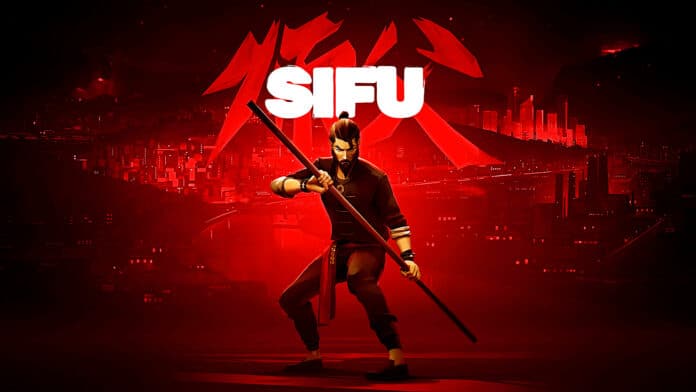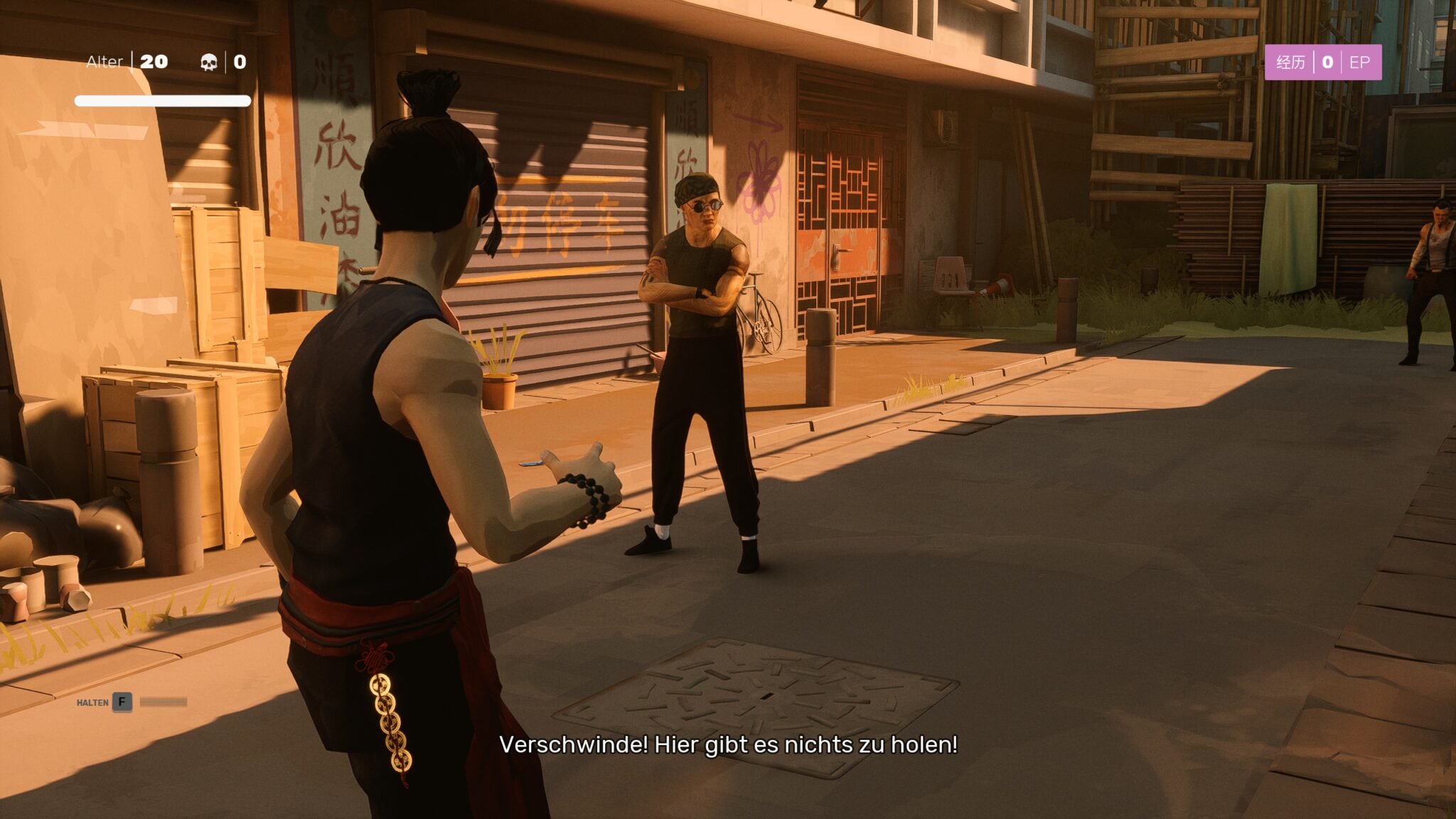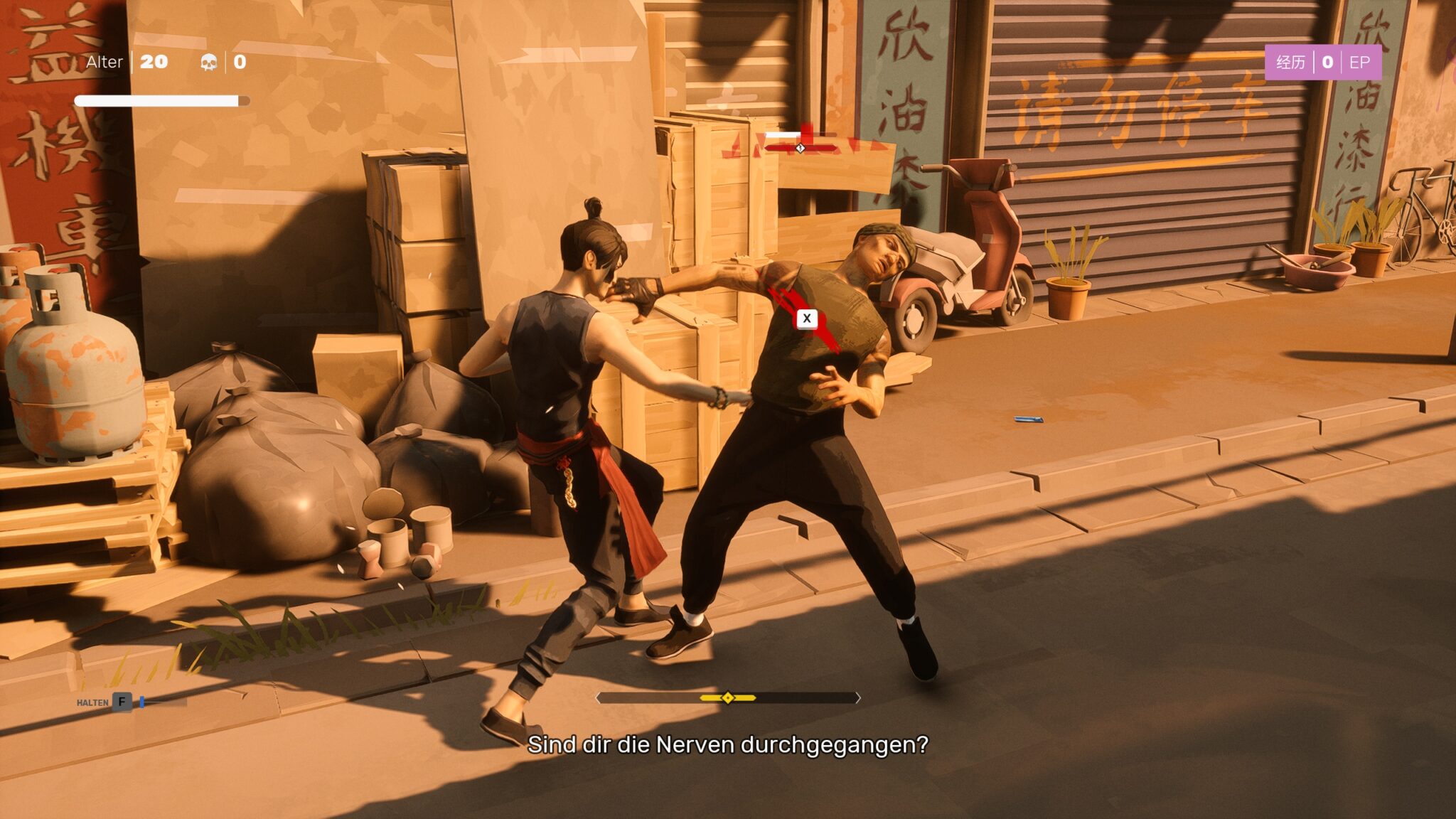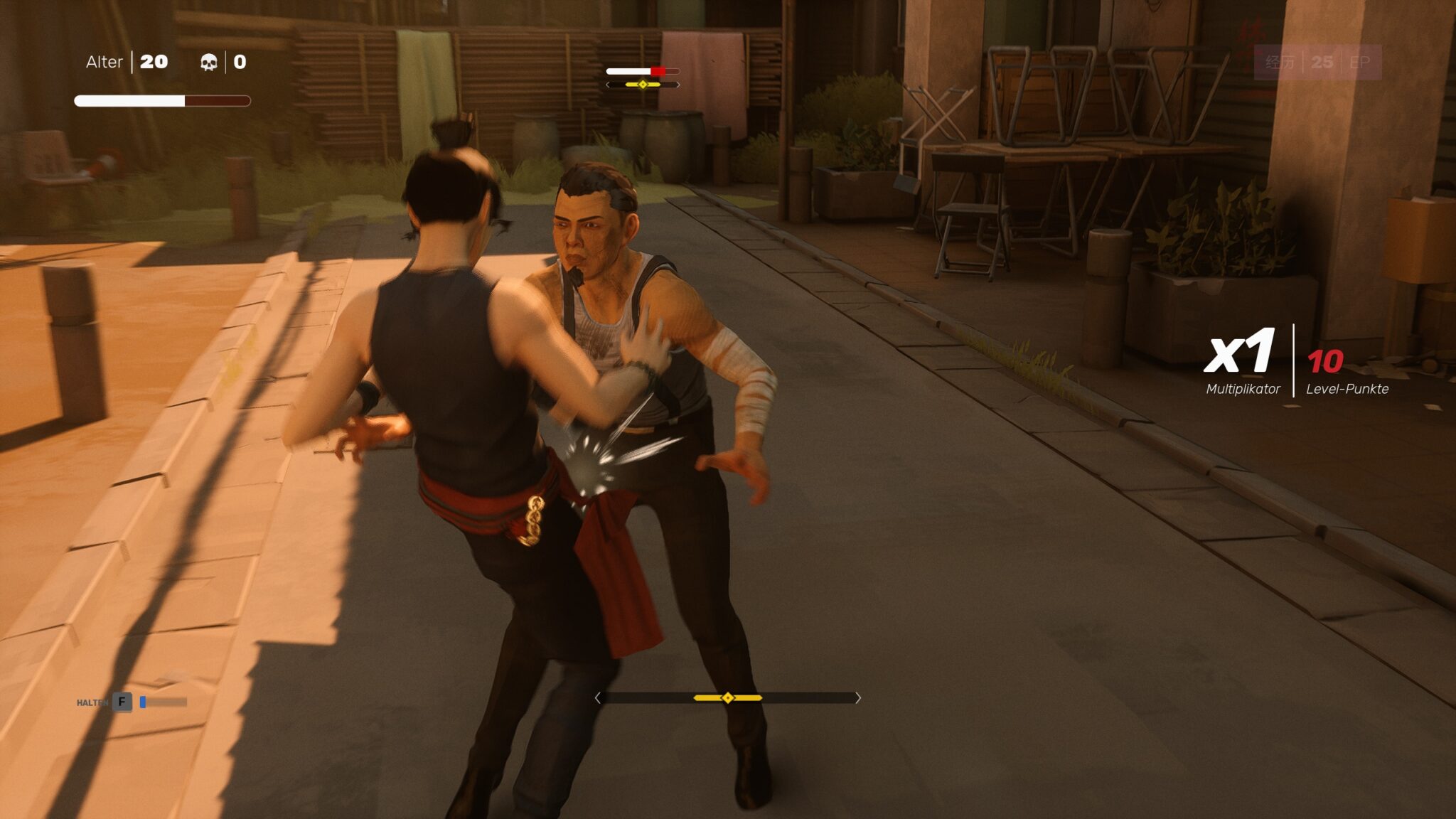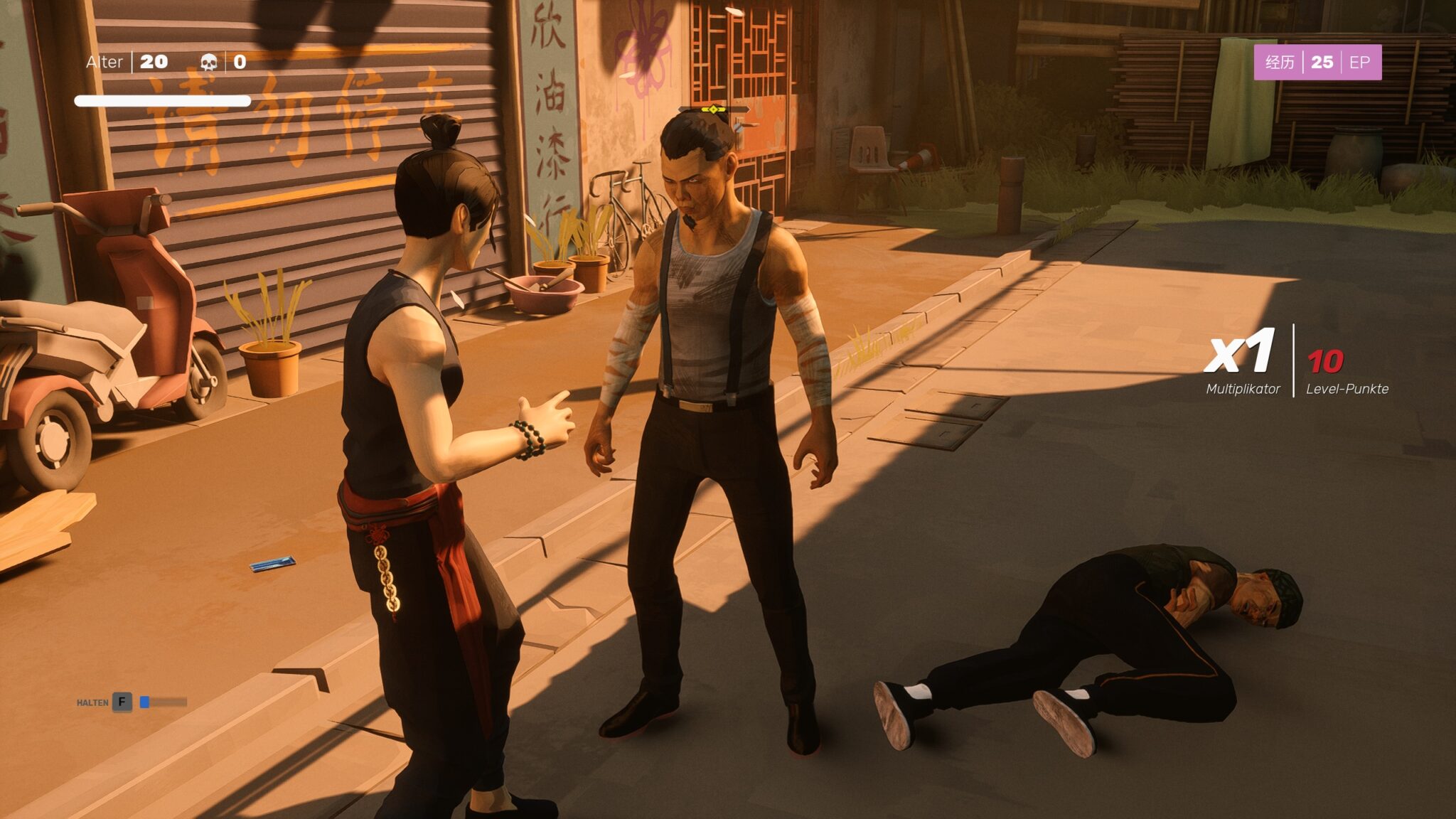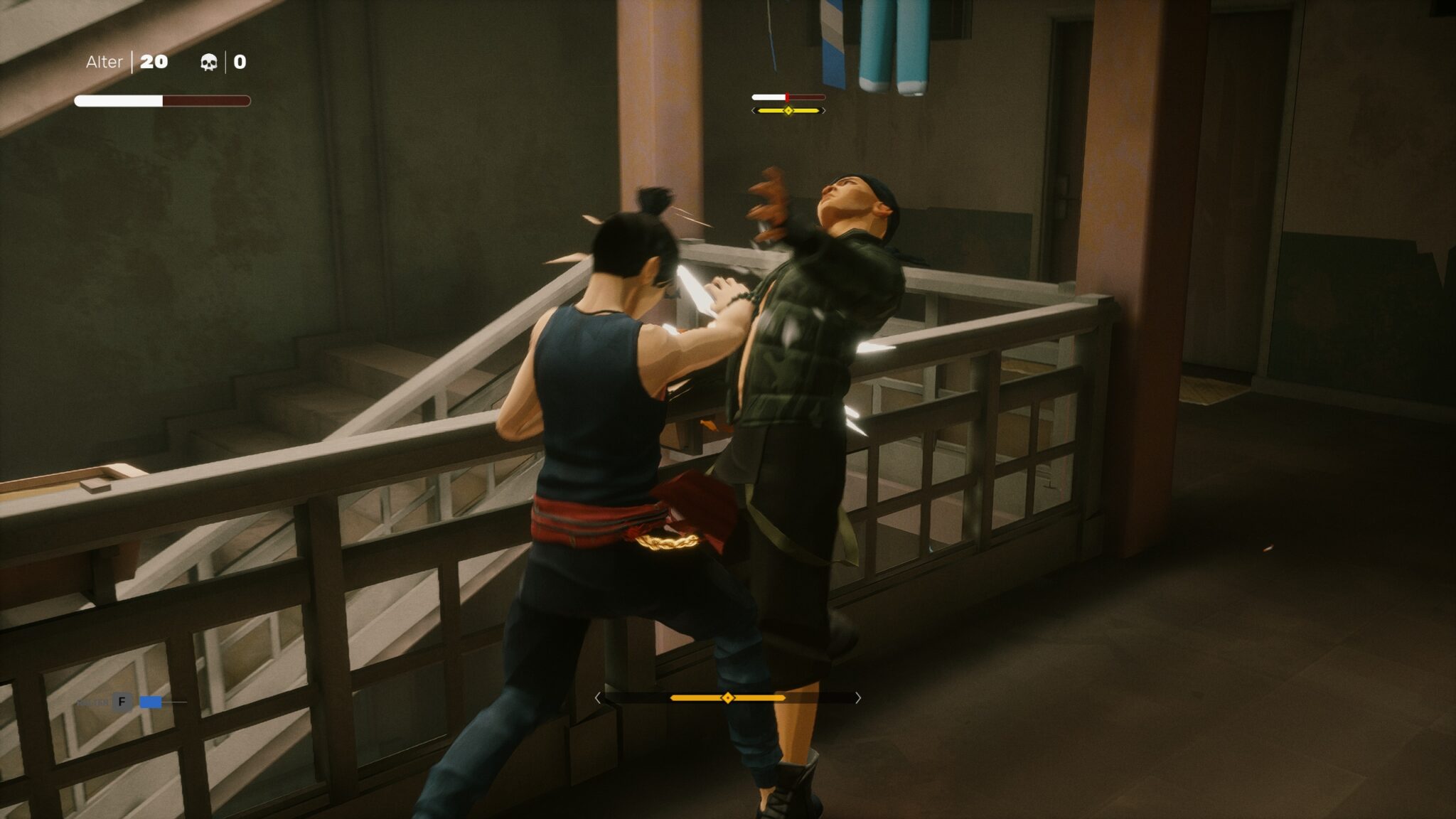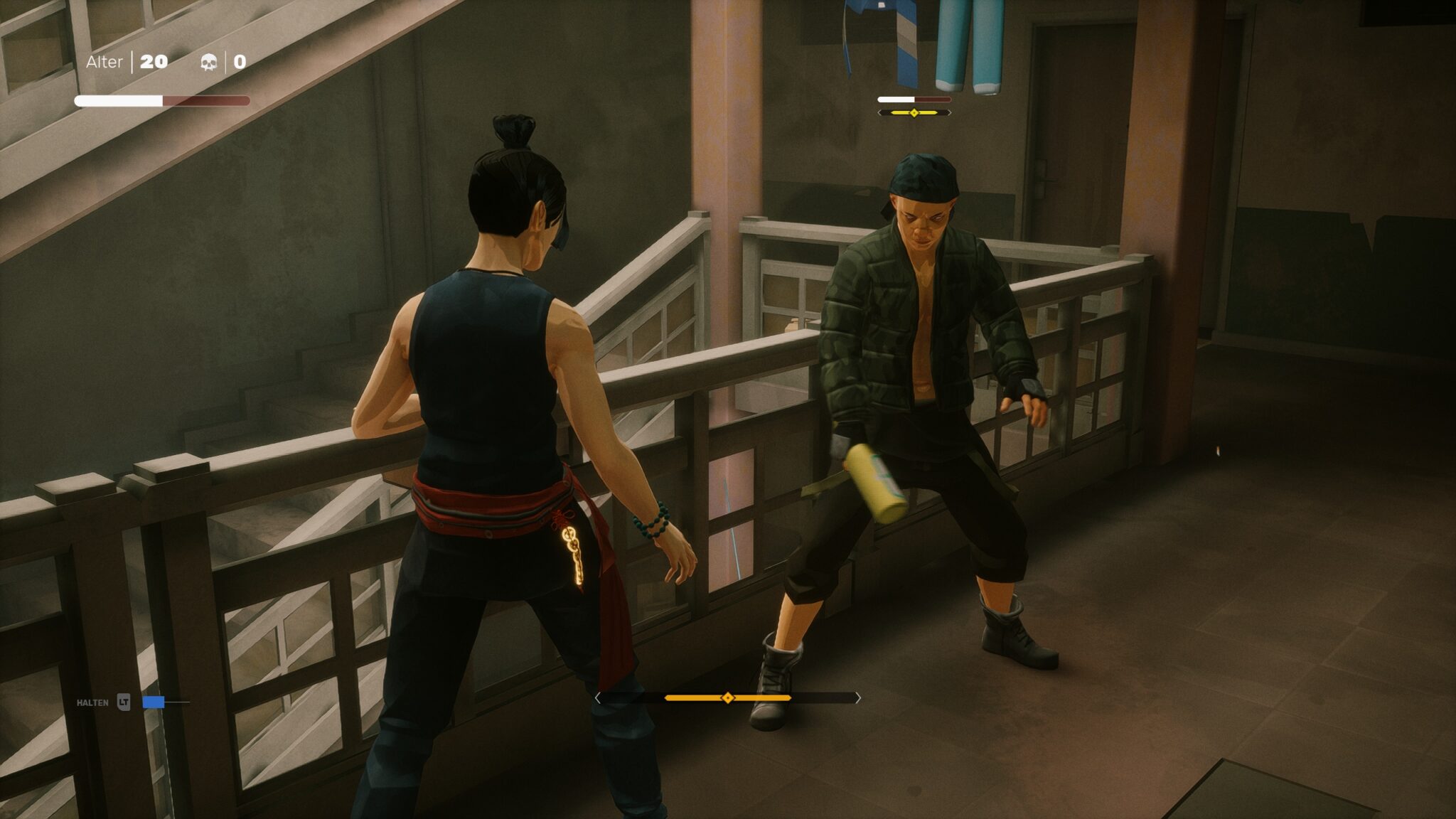This test here almost didn’t happen. Sifu managed to do what neither Sekiro, Dark Souls, Bloodborne, Elex, Kingdom Come, or all the other challenging chunks of testing could.
The last time I felt this clueless was in eighth grade, when all I could choke down on paper in the school exam for the Romantic Era was violins, red roses and candlelight, and of course I got a well-deserved F for it. So, in a desperate walk to Canossa, I write to the PR department that I just don’t know how to test Sifu because it annoys me more than those ass-sucking machines with the big white gloves from the old Disney cartoons.
The friendly PR manager promptly activates his emergency plan for incompetent games journalists (NFUS for short) and sends me a few tips. I prove my resistance to learning and still get nowhere. So NFUS goes into phase 2: The developers play a patch before release to defuse Sifu. But… somehow it feels even harder afterwards than before.
So I give up. The review embargo from Sifu is over, the contest tests go online, I drown my frustration in work and instead throw myself into the other big issues at hand at GlobalESportNews: Dying Light 2, Warhammer 3, you know.
But. Sifu. No. Don’t let the story end like this!
As I lie awake at night, I make a vow. I will play through Sifu without cheats and help – and then I write this test, even if no one in the world reads it anymore. Since then, I sit on Sifu every day after work. And the game remains the most frustrating experience of my career for many evenings.
Table of Contents
What is it all about?
Sifu is old school, a beat ’em up with no frills. As either a male or, in my case, female kung fu genius, I fight my way through five levels, defeat the boss at the end of each level and that’s it. The Sifu developers breathe martial arts films, because all kinds of allusions seep out of every pore of the game. You can also see it well here:
Sifu nevertheless tells its own story, which knows how to stage itself in a cinematic way, especially in the prologue, but also beyond that. It’s about revenge, family, inner balance, but like a Sekiro, you’ll hardly notice any of it unless you consciously pay attention and study all the hidden clues in the levels. This search is worthwhile, because even after playing through the game you can unlock many a secret.
Does Sifu have a New Game Plus?
When you play through Sifu, you can still freely jump between all five levels to collect the last clues (i.e. collectibles in the game world). Look closely at these clues. Maybe you can use them to open locked doors in older levels … or make older boss fights end differently? I can’t give you any more tips without spoilers.
So, before I give too much away, let’s jump straight into the nitty gritty. Because there’s one thing you can take from me: If you want to play through Sifu in under 15 hours, the story is the absolute last thing you’ll have any nerve to do during the journey.
The pure martial arts dream
I’ve got my mouth so full. Sifu, oh, I’m testing this on the side, I love games like Streets of Rage 4. And in the first few minutes of play, I get exactly what I expect. As a 20-year-old kung-fu fighter, I sprint through the dirty backyards of a big city because I want to get some creep.
Promptly the first henchman gets in my way with gruff words – and of course the guy gets a direct smack!
While the first adversary is culinary exploring the tarmac, Sifu’s operation feels like coming home. With one key I give out quick spankings, with the other strong ones … there comes the second henchman and gets – right -, of course, one too:
This is exactly what I wanted: “John Wick” as a kung fu game. My warrior storms straight out of the alley and into a flat stairwell that could be straight out of “The Raid”. And while I carpenter my way from room to room, Sifu becomes second nature to me. I block enemy attacks as easily as child’s play with the right key, throw villains from the third floor, kick enemies out of the picture so hard that even Bam Lee drops the water cup.
What starts out as an action flirtation in the stairwell turns into pure martial arts lovemaking in the next section: a hallway fight that could be taken one-to-one from the most famous film models “Old Boy”, “Dardevil” and “The Raid”. Armies of gangsters pounce on my warrior with fists, pipes and truncheons, but she hands out harsher punishments than the MOT did on my driving test.
In Sifu I can disarm enemies, pick up any cane myself and massage it on opponents until the thing is just a stub. So the very first level begins like a John Wick action dance made into a game. I laughed out loud while playing. That’s exactly what I wanted!
And then I enter a balcony in the next section and am bludgeoned to death in a second and a half. Now begins Sifu.
How long is Sifu?
The playing time of Sifu is a sticking point. If you get through without any problems, you’ll be done with the game in four to five hours, if that. The thing is … no one aside from Chuck Norris can really do that. It took me close to 15 hours with all my replays, maybe you can do it in 10 or 20 hours. Either way, Sifu aside, it’s not a girth beast: You’ll have seen everything in the five linear levels very quickly. That’s not worth 40 euros to everyone.
Easy to learn, difficult to … @ $% &!
This ain’t gonna be the old Dark Souls story. No Oh, I got my ass kicked so many times, but after my victory, I was all the more jubilant, splashing champagne all over the screen. Sifu reminds me much more of real karate training. There is not this one victory that changes everything. There is only the way. Or as the legendary karate master Gishin Funakoshi said: It’s not the size of your privates that matters, it’s the size of the hand that lands a hit there. Although … no, that was from Ameridote.
What Gishin Funakoshi is really supposed to have said: If you practised the kata 1,000 times, you practise it 10,000 times after that. And that’s how Sifu plays. You will fail a dozen times in many places, only to struggle your way to the boss of a level – and there eat dust again a dozen times. Even if you defeat the boss – and this is the big difference to Sekiro and Dark Souls – you have to play through the completed level again and again to increase your chances for later.
Why is that? In Sifu, every death ages you. And pretty darn fast, too. My fighter starts at a fresh 20, after the first death she’s 21, after the third 24, after the fourth 27, after the fifth 32 – so there’s a multiplier that ticks up with every death. Or in other words: defeats become more and more expensive. As in real life, your maximum health is reduced over the decades, you can learn fewer new things, cause a little more damage … but at some point it ends. but at some point it’s over. When I conquered the first level for the first time, I was 49. Whew.
When you start the second level at the age of 49, a few deaths are enough to lead you to permanent game over, because you die of old age. What can you do to prevent this? Repeat old levels to finish them younger, i.e. with as few deaths as possible. It’s not so bad, if only Sifu wasn’t so bloody tough!
Mouse vs. keyboard: You can theoretically play Sifu with both input devices, but I clearly advise you to use the gamepad, because the sticks simply allow more precise movements.
What makes Sifu so hard?
Okay, if you really want to master martial arts, you can’t avoid technique training – and that’s why it’s going to be a bit theoretical now. So grab a delicious tea and we’ll work through this together. Maybe I’ll intersperse (even funny clips) or pictures. There are five things that make Sifu one of the hardest games of the last ten years:
No Warning: If you’ve ever experienced an Arkham game, you’ll know the usual markings enemies use to announce their attacks. A blue flash over the head, ah, then I leisurely press the counter button. Sifu does this in a drastically reduced form – and with such tiny time windows that Meep-Meep-Road-Runner looks like a sloth in comparison. Anyone familiar with the famous Daigo moment from Street Fighter 3 can roughly imagine what Sifu demands:
- Mass and class: A single opponent can be really dangerous in Sifu, because the five or six opponent types have completely different attack patterns. But often gangsters attack you in a crowd. What do you do then? Your problem.
- No muss: You must master sifu. Your kung fu genius may learn a few new skills (even over deaths and restarts), but no experience point grind in the world will take the boss fight from you. It’s your fighting skills and only those that count. The levels are also strictly linear. Apart from a few unlockable shortcuts, there’s only ever one way forward.
- The Damage: The main character of Sifu could probably hang me up by my shorts from the hat rack in two seconds, but she doesn’t hold up to much damn. If a stinking crook catches you with the steel pipe two or three times, the candles already go out. And the life bar shrinks as you get older.
The camera: Sifu suffers from a really awkward camera operation. Because you’re constantly fighting indoors, you have to constantly change your position so that the camera doesn’t adjust to your disadvantage. Especially in the fourth level with its narrow lifts, chasms and corridors, this becomes a burden.
Whoever reads all this might think to themselves: oh, tiny time slots, perfect parries, no exp grind – that sounds like Sekiro and Sekiro was really doable. But as someone who tested both games – Sifu and Sekiro – for GlobalESportNews, I had to painfully live through the difference: Sekiro never took away my hope, Sifu did.
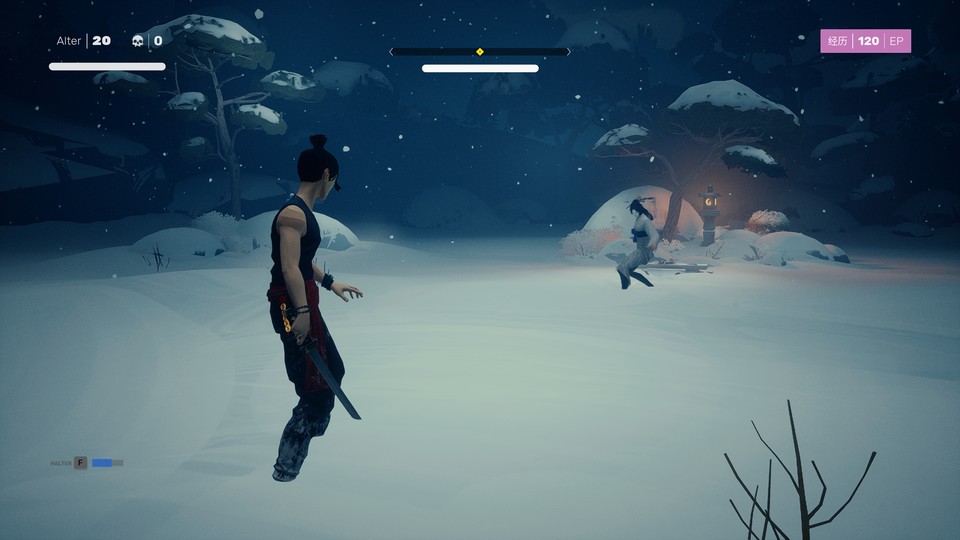
Even in my darkest minute of perpetual failure against Genichiro, there was always light at the end of the tunnel with Sekiro. I must dodge this one hold, parry this one bow volley perfectly in time Bam, bam – ba-bam, then victory is mine!
In Sifu, the first boss blows my lights out so quickly that my finger searches for Alt+F4, completely discouraged. How am I supposed to do this? I see no pattern at all, no opening, just uncontrollable death rolling in again and again with its machete. And even if I defeat the boss, how am I supposed to get to the point where I can get through the whole level and the boss without dying a single time, so that I don’t get beaten up by Fellow Kids as an old geezer in the next level?
But then I understood Sifu. And from here on it got really, really good.
How I started to l(i)eben Sifu
There’s not that one trick that makes Sifu a walk in the park. Sifu remains hard work all the way to the final and beyond. But if you understand the philosophy of the game, that hard work at least buys you free coffee and a packed lunch.
Like most martial arts (and unlike most action games), Sifu is primarily about self-defence. I played this game far too aggressively, wanting to combine light and strong blows into endless chains. The best Sifu manoeuvres do not consist of 20 combo attacks, because hardly any enemy allows more than two hits, but of particularly elegant defences – as in the aforementioned Daigo moment. There are four ways to deal with attacks in Sifu:
- Block: You hold down the block and virtually turn into a living mu ren zhuang wooden frame. As in Sekiro, after too many blocks your stance collapses and you make your will.
- Dodge Step: You can make big dodge steps with the RT button to get out of the action quickly. Especially against groups, this improves your position, but at the same time, the distance to the opponent prevents you from landing attacks.
- Parade: The Parry manoeuvre also works like in Sekiro, but with smaller time windows. If you hammer the block button at the exact moment of the opponent’s hit, you get a parry that does not weaken your stance but that of the attacker. Extremely powerful, but also much more difficult to master than in Sekiro.
- Slips: A speciality of Sifu are the so-called slips, and woe betide anyone who giggles now. In boxing, slipping is called dodging by moving the upper body. In Sifu, if you move the stick while holding down the block button, you dive under punches, pull your own torso to the side or even lift your leg to avoid the sweep. Slips are relatively easy to do, but they don’t interrupt the enemy’s combo – so you sometimes have to chain five successful slips together to escape a single combo attack.
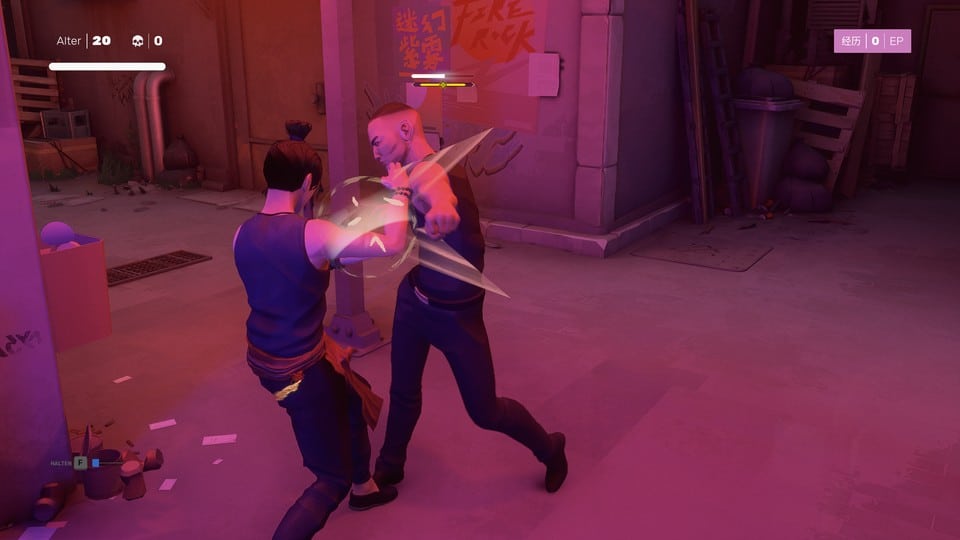
You need to master these four defensive techniques to stand a chance in Sifu. And how do you master a parry when the enemy is attacking impossibly fast? That’s right, by dull memorisation. You have to cram all the combo manoeuvres of the (end) opponents to know exactly in which beat to slip, parry or block. This is the one point where I contradict the cheering fanfares of the Sifu fans.
Sure, in principle this dry cramming fits in with the whole apply-and-polish philosophy. You train motor memory and end up amazed at the manoeuvres you effortlessly dodge. But ironically, the martial arts facade crumbles when I only successfully parry by predicting exactly how the enemy must attack, because we’re in a video game and the AI can only do a very specific five manoeuvres that I have dully memorised.
Sifu would be perfect if it gave me a little more room to improvise. The difference to Sekiro is gradual: Sekiro also requires exact parry manoeuvres, but because the time windows are more generous, I at least have the chance to grab the next boss on the first try without knowing every feint by heart. In Sifu, that’s much, much, much harder because the bosses attack so insanely fast and their combos are almost indistinguishable from each other at first.
Maybe additional difficulty levels will turn things around here, which the developers have announced for an upcoming patch.
And this is still fun now?
Whoever had to cram the “Sorcerer’s Apprentice” in school knows: memorising is as much fun as a tartar removal at the butcher. And even if you study manoeuvres like mad in Sifu, chances are you just can’t play through this game. After all, many soul games (and sorry to use the comparison so often, but no other genre comes close to Sifu’s level of difficulty) give you ways around the difficulty. Co-op, experience grind, certain items. Sifu has none of that.
Like a Russian matryoshka, Sifu is aimed at a very, very specific target group within a very, very specific target group. Hence my long sermon at the beginning: even for me as a Sekiro fan, this game was almost too hard – you decide for yourself where you place yourself. And now comes the big but.
I simply can’t deny how great I felt after I finally understood Sifu. In Sekiro or Dark Souls, you have that exultant feeling of barely making it through the boss on the 100th try, but Sifu is in a different league: by the time you reach the end credits, no boss in the game will make you smile.
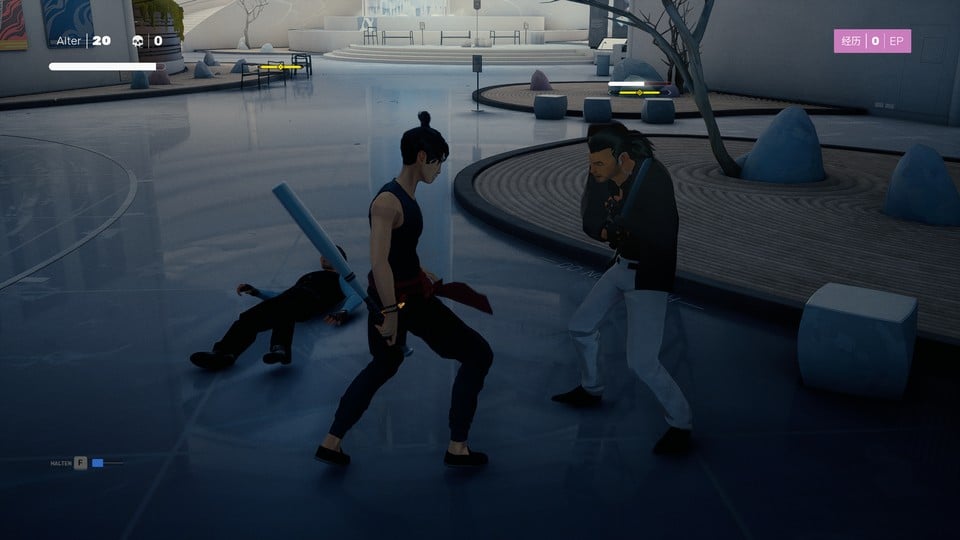
Sifu helps you to surprise yourself. At the beginning you think the bosses are completely impossible, you virtually die your way through the fight. At the end of the journey, the staff master from the second level merely hits the air next to you. You win not only without a single death, but without a single touch. Sifu lets you experience mastering an ability in a similar but different way to Sekiro. It is not a stop-and-go, but a very arduous, continuous climb. And once you reach the top, you are truly invincible.
By now I’m really going through sifu levels like Jean-Claude Van Damme. But the road here has been much harder, tougher, more frustrating than I initially thought possible – and it will never bring joy to many people out there. But I will never forget this journey … And overall had a great time despite, or perhaps because of, all the adversity.
Editorial conclusion
There are a few things that adults should leave behind. Children’s slides, sandpits, booger nibbling, console wars as well as this unspeakable habit of putting Git Gud or So I thought it was super easy on other people’s bread. Or as Gishin Funakoshi said in the 1950s: A truly crass sow doesn’t have to brag on the internet. I’m sorry, first and foremost, that so many people probably won’t have any fun with Sifu. Because the action clunker doesn’t even need the brutal toughness to be one of the best martial arts games ever.
To experience it at this point in time (i.e. before the announced accessibility patch), however, you’ll have to tread the same path of pain as I did. And it really took everything out of me: mastering the perfect defence, memorising all enemy attacks, tediously repeating the same corridors over and over again … that price is high. But in return, I now really feel like a master of martial arts. No boss can even hold a candle to me, even the last boss just punches the air – such a profound feeling of mastery is very, very rare to experience in games. And in real life, too, to be honest.

